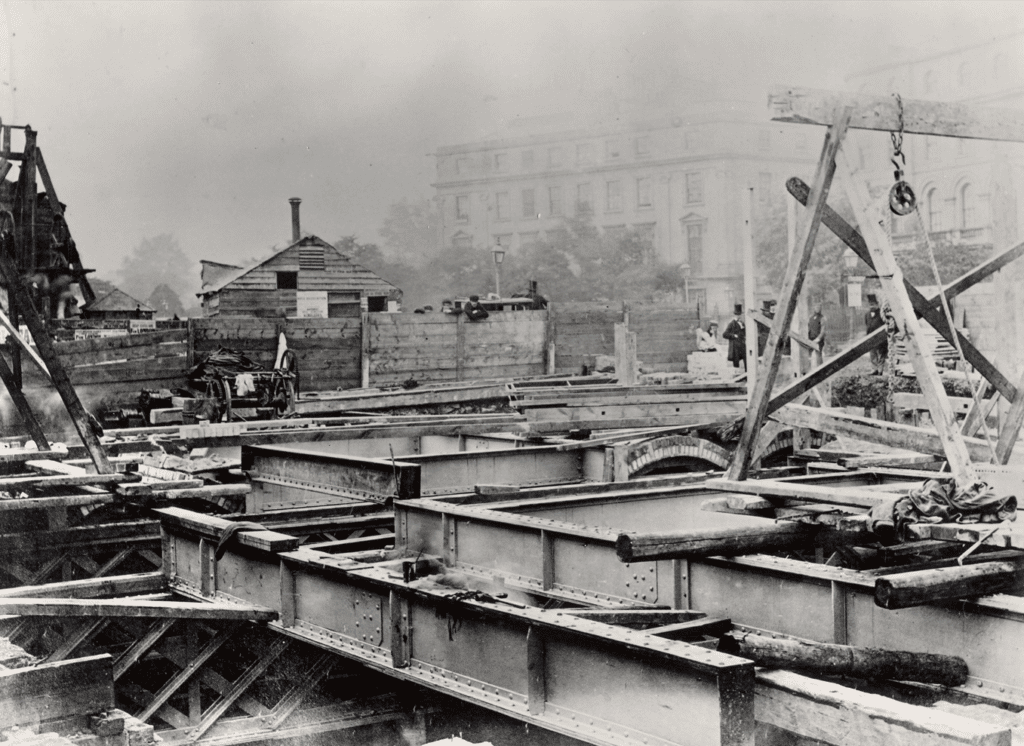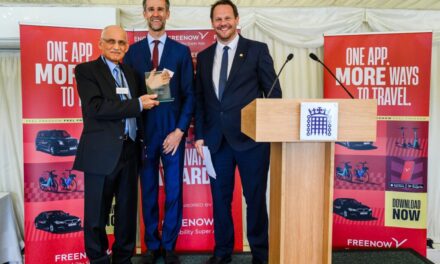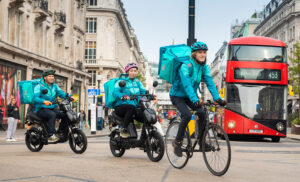Today marks 160 years since the first Tube journey took place between Paddington and Farringdon stations, on what was then the Metropolitan Railway.
To mark this milestone birthday, the Mayor of London Sadiq Khan met with four London Underground staff members who have given a total of 160 years of service in a range of roles.
The celebration took place at Baker Street station, one of the original stations that opened on 10 January 1863, and also saw the Mayor unveil a special 160th year roundel, Love the Tube, that customers will be able to spot at stations across the network including at Gloucester Road, Brixton, Oxford Circus and Covent Garden.
The Tube has always played an important role in the success of London. The growth of the early network led to the expansion of the suburbs in the last century, while the extension of the Jubilee line led to the development of Canary Wharf’s financial powerhouse in the 1980s. The Northern Line Extension’s opening in 2021 has enabled the growth of the Nine Elms and Battersea areas, and today’s system, which is once again moving millions of people around every day, helps London continue to recover from the pandemic.
Advertisement
Tube ridership has steadily increased since the pandemic and is now at around 80 per cent, across a weekly average, compared to pre-pandemic levels – with weekend ridership increasingly edging towards levels seen before the pandemic.
A programme of activities throughout 2023 will celebrate London Underground’s role as the lifeblood of the city, connecting Londoners with work and leisure opportunities for the past 160 years. Activities will be themed around the Tube’s innovation, its contribution to improving the environment, how the Tube connects people and places, how it supports diversity and inclusion, and its unique and world-renowned architecture and design. First up will be a self-guided treasure hunt across all of the original Metropolitan Railway stations on 21 January, including Farringdon, Baker Street and Paddington, encouraging participants to see these historic stations in a new light. Further details can be found here: tfl.gov.uk/Tube160.
The London Transport Museum will be supporting the celebration of the Tube with activities throughout the year, highlighting the heritage and innovation of the world’s most iconic underground railway. This will be alongside the museum’s permanent exhibitions, which encourage visitors to explore the Tube’s origins as the world’s first subterranean railway.

The Mayor of London, Sadiq Khan, said: “I’m delighted to kick-start a year of celebrations as the world’s first underground railway – the Tube – marks its 160th birthday, unveiling a roundel at one of our oldest Tube stations, which celebrates London’s affection for our world-famous underground.
“The Tube is a true London icon, connecting people across the capital and transporting tourists and commuters across the city. On 10 January 1863, the world’s first underground railway opened and from that day forward the London Underground has been at the heart of the capital’s history, continuing to grow and evolve alongside the city it transports. I’m so proud of the history of our Tube and I’m determined that the London Underground will continue to deliver a world-leading service fit for the 21st century, and contribute to a better, safer and fairer city for all Londoners.”
Andy Lord, London’s Transport Commissioner, said: “A milestone birthday gives us the perfect opportunity to reflect on the historical significance of the Tube and how it has expanded and improved to meet the needs of an ever-changing world city. During this time the Tube has breathed new life into unconnected parts of London and been the catalyst to many local economies. It also gives us the opportunity to look forward to the next raft of improvements and to continue planning to ensure that the Tube serves our city ably and efficiently for the next 160 years.”
Sam Mullins OBE, Director of the London Transport Museum, said: “The opening of the Underground in 1863 and its evolution over the past 160 years has continually shaped London. Deploying cutting edge engineering, design and service innovation, the Underground has kept the city on the move and given it the strong character we know today. The network has both responded to and promoted the growth of the city, spurred regeneration, connected communities and made it accessible to residents and visitors alike. We look forward to welcoming visitors to the Museum in Covent Garden to share this fascinating lens for London’s history.”

Sharon Ament, Director, Museum of London, said: “All of us at the Museum of London wish the London Underground a very happy birthday! The Tube has had a transformative impact on our city for more than a century and a half. It’s a fundamental part of London’s DNA and of course it keeps evolving; it reaches further, new lines are added, it modernises and as part of our day-to-day lives it keeps us connected. Above all it allows us to explore and enjoy everything London has to offer.”
Advertisement
Richard Burge, Chief Executive of London Chamber of Commerce and Industry (LCCI), said: “Over a remarkable 160 years, the London Underground has become synonymous with London and is a crucial part of our capital city’s infrastructure. The Tube provides businesses with essential transport connectivity on a daily basis and where the tube goes, investment, innovation and productivity follow. The Tube has played a major role in establishing London’s reputation as the best city in the world to start and run a business. Through continued investment and development, it will no doubt continue to boost London’s economy and connect Londoners for the next 160 years and beyond.”
A range of further improvements to the London Underground network are on their way including new trains to replace the ageing Piccadilly line fleet and new signalling on the District, Hammersmith & City and Metropolitan lines as part of the Four Lines Modernisation programme (and following the completion of new signalling on the Circle line last year). The project to modernise and expand Bank station is also nearing completion, transforming customer journeys at the heart of the city. Further significant improvements will also be delivered on the Elizabeth line – the evolution of the Tube network – with an increase in frequency and through-running to more destinations introduced later this year.

Key dates in London Underground’s history:
A full list is available here but highlights include:
1863 – On 10 January, the Metropolitan Railway opens the world’s first underground railway, between Paddington (then called Bishop’s Road) and Farringdon Street
1868 – The first section of the Metropolitan District Railway, from South Kensington to Westminster (now part of the District and Circle lines), opens
1880 – Running from the Tower of London to Bermondsey, the first Tube tunnel opens
1884 – The Circle line is completed
Advertisement
1890 – On 18 December, the City and South London Railway opens the world’s first deep-level electric railway. It runs from King William Street in the City of London, under the River Thames, to Stockwell
1900 – The Prince of Wales opens the Central London Railway from Shepherd’s Bush to Bank (the ‘Twopenny Tube’). This is now part of the Central line
1906 – Baker Street & Waterloo Railway (now part of the Bakerloo line) opens and runs from Baker Street to Kennington Road (now Lambeth North). Great Northern, Piccadilly & Brompton Railway (now part of the Piccadilly line) opens between Hammersmith and Finsbury Park
1907 – Charing Cross, Euston & Hampstead Railway (now part of the Northern line) opens and runs from Charing Cross to Golders Green and Highgate (now Archway)
1908 – The name ‘Underground’ makes its first appearance in stations, and the first electric ticket-issuing machine is introduced. This year also sees the first appearance of the famous roundel symbol
1933 – The Underground Group and the Metropolitan Railway become part of the London Passenger Transport Board, taking control of all the capital’s railway, bus, tram, trolleybus and coach services. Harry Beck presents the first diagram of the Underground map
1940 – Between September 1940 and May 1945, most Tube station platforms are used as air raid shelters. Some, like the Piccadilly line (Holborn – Aldwych branch) are closed to store British Museum treasures
1952 – The first aluminium train enters service on the District line
Advertisement
1961 – The end of the steam and electric locomotive haulage of London Transport passenger trains
1969 – HM the Queen opens the Victoria line
1971 – The Victoria line extends to Brixton
1975 – A fatal accident on the Northern line at Moorgate kills 43 people. New safety measures are introduced
1977 – The Queen opens Heathrow Central station (Terminals 1 2 3) on the Piccadilly line
1979 – The Prince of Wales opens the Jubilee line
1984 – The Hammersmith & City and Circle lines convert to one-person operation
1986 – The Piccadilly line is extended to serve Heathrow Terminal 4
Advertisement
1987 – A tragic fire at King’s Cross station kills 31 people
1989 – New extensive safety and fire regulations are introduced following the Fennell Report into the King’s Cross fire
1993 – Work started on the extended Jubilee line from Green Park to Stratford
1994 – Penalty fares are introduced. London Underground takes over the Waterloo & City line and responsibility for the stations on the Wimbledon branch of the District line from Putney Bridge to Wimbledon Park. Aldwych station, and the Central line branch from Epping to Ongar, closes
1999 – London Underground is restructured in preparation for Public Private Partnership. The extended Jubilee line opens, offering through-services from Stanmore to Stratford
2000 – TfL is formed bringing London together into one integrated transport body
2002 – TfL’s online Journey Planner is launched, enabling customers to plan journeys across several modes
2003 – London Underground becomes a wholly owned subsidiary of TfL. A comprehensive plan followed to improve the Tube, refurbish hundreds of stations, upgrade lines to provide faster, more frequent and reliable services, install step-free access at many locations, and entirely rebuild some central London stations that became too small to deal with the number of people passing through every day. The Oyster card is introduced. Busking is legalised
Advertisement
2005 – 52 people are killed in bomb attacks on three Tube trains and a bus on 7 July
2007 – The Tube carries one billion passengers in a year for the first time. The East London line closes for rebuilding and extension as part of new London Overground network
2008 – Piccadilly line extension to Heathrow Terminal 5 opens. Metronet transfers to TfL control. First new station on an existing Underground line for 70 years opens as Wood Lane station (Hammersmith & City line)
2009 – The Circle line changes shape. Kings Cross St Pancras station upgrade is completed and becomes step-free the following year, ahead of the London 2012 Games
2010 – HM the Queen visits Aldgate station. LU achieves Carbon Trust Standard. The first air-conditioned, walk-through Underground train runs on the Metropolitan line
2011 – A full fleet of new Victoria line trains become operational. Green Park becomes step-free to provide easier access to the Victoria, Piccadilly and Jubilee lines in time for the London 2012 Games
2012 – London successfully hosts the first public transport Olympic and Paralympic Games with reliability across the Tube network averaging no lower than 97 per cent during this period
2013 – TfL celebrates the 150th anniversary of London Underground. Walk-through, air-conditioned trains with improved accessibility features are introduced on the Circle line
Advertisement
2014 – Contactless payments are expanded across the Tube, Tram, DLR and London Overground networks. Major Northern line signalling upgrade is completed
2016 – Night Tube is launched offering all-night services at weekends
2019 – The busiest day in the Tube’s history is recorded on 29 November with 5.1m passenger journeys
2021 – TfL launches its first journey planning app, TfL Go
2021 – The Northern line is extended to Battersea Power Station and Nine Elms, supporting the complete regeneration of the area
2022 – The Elizabeth line – the evolution of the Tube network – is opened by HM the Queen. The Circle line becomes fully automated























